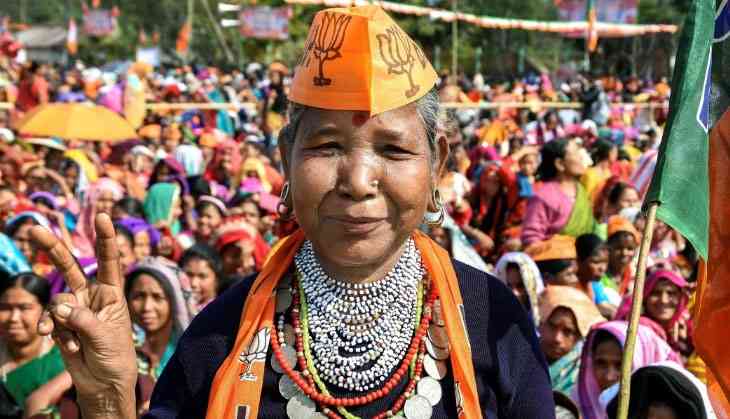Tripura elections 2018: Three factors that led to BJP's victory in Tripura

- The BJP's vote share in Tripura has never exceeded 10%. Even during the Narendra Modi wave in the 2014 Lok Sabha elections, the party got just 5.5% votes. This has increased to 43% for the BJP on its own and 50.5% along with the IPFT. This is an increase of nine times since 2014.
- This is the best performance by a non-Left party in Tripura ever since the Congress got 58% votes in the first Assembly election in the state in 1967, over half a century ago. It is better that what the Congress managed to achieve in 1988, when it was at its peak nationally under Rajiv Gandhi and managed to defeat the Left in Tripura.
- The BJP-IPFT alliance has managed to win seats like Simna, Mandaibazar, Pratapgarh, Ramchandraghat, Asharambari, Krishnapur, Sabroom Surma, Pabiachhara Panisagar, which the Left hasn't lost since it first came to power in the state in 1977.
Congress-Mukt Tripura
The BJP has taken over the entire Congress vote in Tripura. The Congress' vote share in the state has consistently been above 40% as it was the main Opposition party in the state. It has fallen to less than 2%. The entire vote has gone to the BJP. However, it does seem that a substantial chunk of Congress' Muslim voters moved to the Left Front and not the BJP.
The Left Front managed a significant vote share of 45%, a fall of 7% from 2013. It is clear, therefore, that the BJP largely gained at the Congress' expense, with only a small chunk of disgruntled Left voters flocking to it.
The Congress appears to have paid the price for its alliance with the Left in 2016 in West Bengal. This decision triggered an exodus of party workers and leaders, who no longer trusted the party to take on the Left in Tripura.
Urban sweep
The BJP's dominance was most apparent in urban areas. It has won all the seats in Agartala. It's state unit chief Biplab Kumar Deb won from Banamalipur in the heart of the city and he's likely to be the new chief minister of the state. It also emerged victorious in other seats in the state capital such as Bordowali, Agartala, Ramnagar, Badharghat, Barjala, Suryamaninagar and Pratapgarh
It also won in other urban centres like Dharmanagar, Mohanpur and Bishalgarh. Curiously, it lost in Kailashahar to CPI(M)'s Mobashir Ali mainly because Congress candidate Birajit Sinha managed to get 7700 votes.
Unemployment among the youth was a major issue in urban areas and BJP appears to have done phenomenally well among young voters.
Tribal areas
BJP's alliance with the IPFT appears to have worked wonders in the areas dominated by Tripura's indigenous people. The alliance won alliance has won 16 out of 20 seats reserved for Scheduled Tribes. CPI(M) won three. In one seat, counting is yet to take place.
This is CPI(M)'s worst ever performance in Tribal areas. Even when it lost in 1972 and 1988, it had won 10 ST seats.
The BJP-IPFT alliance managed to capture the resentment of the indigenous people, particularly the youth, against the Left.
There was also a complete shift of tribal votes from the INPT to the IPFT. Last time, the INPT got 7.5% votes in the state overall and 41% in the seats it contested. This time it was reduced to just 0.7% vote share in the state.
Where the Left managed to do comparatively better are rural seats dominated by Bengali speaking farmers. The Left managed to win close to half these seats, indicating that it's base in these areas is intact. It also managed to win the three seats where Muslims form a significant part of the electorate: Boxanagar, Kadamtala Kurti and Kaliashahar.
Is this BJP's biggest triumph ever?
The BJP's win in Tripura might seem inconsequential from the perspective of the 2019 elections as the state just has two Lok Sabha seats, it is perhaps the BJP's most significant win under Prime Minister Narendra Modi and BJP president Amit Shah.
Till now under Modi, the BJP has done well in two kinds of states:
First, where it's main rival is the Congress - Haryana, Jharkhand, Assam, Himachal Pradesh, Uttarakhand, Goa, Gujarat and Manipur. Even in Jammu and Kashmir, BJP did well only in the Hindu-dominated Jammu region where it was up against the Congress.
Second, states like Maharashtra and Uttar Pradesh, where Congress was one of its rivals but the BJP benefitted from the fact that it always had a base in the state.
In contrast to these were states like Delhi, West Bengal, Kerala and Tamil Nadu, where the party lost to powerful regional parties/alliances.
Tripura is the first state in which the BJP has managed to defeat a powerful, cadre-based regional formation like the Left Front, that too in a state where it had little presence until three years ago. This is an important lesson for several regional leaders like Naveen Patnaik, K Chandrasekhar Rao, Mamata Banerjee and Pinarayi Vijayan. Interestingly, this is also one of the few states where the party won without making any appeals to Hindutva.
Amit Shah made his intentions clear during his post-victory press conference on Saturday when he said, "Our golden era will begin when we win Odisha, West Bengal and Kerala as well".
First published: 3 March 2018, 21:06 IST

